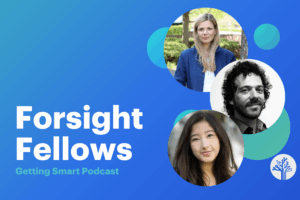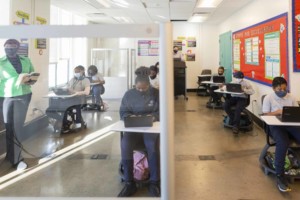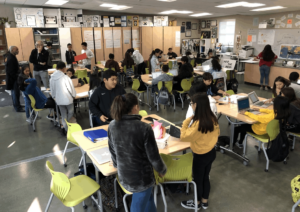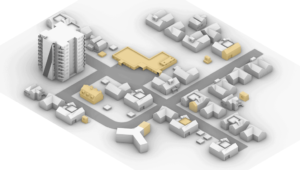Learning Conducive to Life: A Radical Approach at the Biomimicry for Regenerative Design Lab at Green Schools Bali
Key Points
-
The BiRD Lab at Green School Bali uses nature-inspired learning and the 4S approach (Sensing, Seeking, Shaping, Storytelling) to foster systemic change and promote sustainable and regenerative design.
-
Systems change doesn’t require burning everything down. Instead, it begins by changing perceptions, asking new questions, imagining possibilities, and acting with regenerative intentions.

By: Benjamin Freud
“Change without change” is a concept in physics that says you can alter how you describe something mathematically, but the actual outcomes remain exactly the same. This also occurs in education when we change posters and measurement methodologies, expecting systemic change. Using the master’s tools to dismantle the master’s house, as Audre Lorde says, is a dangerous recipe for stagnation and complicity. In this equation, systemic and narrative change are not guaranteed, nor are they likely. Rather, this approach merely finds ways to navigate changing conditions, without challenging extraction, atomization, reductionism, or meritocracy. It is change without change because we don’t consider other ways of participating [in/as] the world.
Real systems change happens when we not only acknowledge that we are the system, but also that we are continually co-creating the system through our entangled behaviors. These very behaviors themselves are shaped by the same dynamic systems we keep remaking. It is a reciprocal creative process. (I am considering schools, and the education one receives there, as a system.)
In other words, systems aren’t static and immovable. They aren’t fixed and “out there.” To paraphrase French philosopher Bruno Latour, systems are kept alive because people do things in their name. Every time we show up in some way, we re-create systems. New paradigms aren’t created ex nihilo; they emerge from the decay of their predecessor. In other words, paradigms are composted to create fertile soil for new paradigms. This is what Vanessa Andreotti means by hospicing (modernity).
Systems change doesn’t need seismic shifts at a global scale. It doesn’t demand we burn it all down and hope for the best. It doesn’t even require a definite plan (in fact, that would be contradictory to systems change). Systems change begins when we start to change the way we perceive the world, leading us to ask different questions, imagine new possibilities, and act with (regenerative) intentions to create new worlds. It is through this that we participate differently [in/as] the world.
Until schools act with the intention to create new paradigms, they’re just going through change without change. True change will require It will require a re-thinking of our relationship with the world,
The Biomimicry for Regenerative Design Lab
This is a story about the Biomimicry for Regenerative Design (BiRD) Lab at Green School Bali where the mission is “a community of learners making our world sustainable.” It is a story about how perceiving our participation [in/as] the world differently might lead us to act with regenerative intentions to create new worlds. Most importantly, it’s a shared invitation to be inspired by Nature so that we may engage in regenerative design.
For 3.8 billion years, Nature has sensed changes in its environment and adapted to find optimal conditions for interdependent life forms within it. These changes happen concurrently and interdependently within a life form and outside it. It is a collective adaptation. Nothing happens on its own in Nature. Life is always adapting to and with other life, through constant interactions (Maturana and Varela’s structural coupling). In Life’s complexities, there is no linear cause and effect, and we are sometimes surprised. Flowers are bright blues and yellows because they have adapted to what pollinators find visually attractive (based on their visual and olfactory fields).
Nature adapts in ways to solve every problem it encounters. In fact, there are no “problems” in Nature; there are adaptations that move toward homeostasis—the optimal conditions for interdependent life to thrive. Nature has adapted to the previous five mass extinctions and will do so once this sixth (human-accelerated) subsides. Nature is the model of resilience.
Nature’s creatures have evolved and continue to adapt to be physiologically perfect to meet their needs: a bird’s lightweight, aerodynamic skull enables efficient flight; a whale’s circulatory system manages oxygen and pressure for deep dives; and a spider’s feet are designed to detect the slightest vibrations through their webs, allowing them to read their environment with extraordinary accuracy even though their eight eyes aren’t particularly good at seeing (according to human terms).
What would happen if we learned from how Nature continues to evolve toward, as Janine Benyus, founder of the Biomimicry Institute, says, ‘conditions conducive to life’?
The 4S Approach
Of course, there are many ways to approach learning from Nature.
The Biomimicry for Regenerative Design Lab is housed in three buildings on the Green Schools Bali campus, but it’s really a mindset that can be leveraged anywhere using the 4S approach. It is an approach that invites conversation, with humility and attentiveness, between all members of the community (human and other-than-human). It asks each member to participate in the design of what it is that we are learning about and what will come of it. Participation is sourced in place and extends across past-present-futures.
Including all members of the community (human and other-than-human, born and future generations) de-centers the individual, de-centers the human, and yes, de-centers the student. Instead, the 4S approach is life-centered.
(Note that when I write that we de-center the student, I am not implying that the student no longer matters. When we center life, there is no other center, and all living beings are included, centered yet uncentered. Rather, de-centering the student is a way to challenge separation, atomization, and competition.)
The 4Ss are sensing, seeking, shaping, and storytelling. Learners (let’s call them designers) flow through each S non-linearly, each with a purpose. The 4Ss are sensing, seeking, shaping, storytelling.
Sensing: The Sensing stage helps learners understand and empathize with the complex realities of the people, places, and other-than-human world that are all too often ignored in school experienced. When our Sensing is more finely tuned, we can better recognize how the design of products and experiences might change to meet the needs of those who have been previously excluded.
The Sensing stage asks What might we learn from listening to the many voices of the community?
Seeking: In the Seeking stage, learners explore and deepen their understanding of what regeneration means to the world, to themselves, and to their projects. They learn not only what new questions they might ask, but also who to ask, and then how to seek real meaning from what they hear.
The Seeking stage asks What is/are the question/s that matter?
Shaping: In the Shaping stage, students use biomimicry to develop innovative, nature-inspired, sustainable, and regenerative project ideas and solutions. They learn how to think as part of nature, rather than just examine nature from a distance without truly understanding the relationship between our wellbeing and that of the natural world that we are part of.
The Shaping stage asks How and what might we learn from Nature’s designs?
Storytelling: The Storytelling stage of the BiRD journey gives learners the tools and practice frameworks to find ways of sharing the key qualities of their idea, product, or service that resonate strongly enough with others for them to want to take the action that’s needed. Stories benefit from design and prototyping as much as products or services do, and the more attention that’s paid to that, the more likely they are to land in a way that works.
The Storytelling stage asks How might we engage with and inspire others?
Low Threshold, Wide Walls, No Ceiling: The Playground Example
The BiRD 4S approach can be used at almost any age. Whether it’s with a group of 2nd or 12th graders, PhD students or professional designers, there is no limit to the possibilities that emerge from listening to the community, asking questions that matter, and designing products and solutions inspired from Nature’s genius, then, in turn, inspiring the world with stories.
Let’s walk through an example briefly. Ask participants to design a playground for primary school children. Using the 4S approach, it might look like this:
Sensing: Bring together a Council of All Beings. Ask participants to take on the roles of one of the following community members who would interact with the playground (or they can choose another, if they’d like). What would they desire from the playground? What would they need to thrive?
| A student in Grade 2 | A groundskeeper | A Balinese child in 2125 |
| A teacher in Grade 4 | A parent (choose age group) | A Balinese child in 1925 |
| A starling who lives nearby | A coconut tree | A firefly in 2050 |
| The CEO of Lego | A fish in the ocean | A current GSB student, in 2045 |
| A gecko in the school | A worm in the soil | An orb-weaver spider in 1000 CE |
Seeking: From the conversations they had, From the notes you made, what patterns are emerging? What questions come up? What bigger, systemic questions emerged? How will these questions serve as guides? What do they reveal as important? Is there one question that matters?
Shaping: This is the more complex one and what happens here really depends on knowledge, sophistication and experience. Yet at any level, one can ask designers to respond to the question that matters that they came up with. They can also explore—in whichever depth is appropriate—How does Nature “do” what it is they want the playground to “do? For instance, How does Nature create tactile richness while maintaining safety?
Storytelling: Designers complete drafts of their playgrounds and share with the community, which in turn provides feedback. If this is a class that has multiple groups, wouldn’t it be wonderful if groups could learn from other groups’ designs and implement others’ ideas and insights with impunity? That is regenerative.
You will note that this exercise can go anywhere and challenge anyone appropriately.
Change That Actually Changes
The BiRD Lab won’t transform education by itself. Alone, it won’t resolve the many crises we face. It doesn’t have the ambition to bring us to enlightenment. What the BiRD does intend is to consider the community (human and other-than-human, intergenerational) rather than the individual.
When we learn&do in ways that consider all other life forms, competencies become means, outcomes become milestones, relationships take precedence. How we show up and what we do reverberates throughout the ecosystem. We understand that our actions are influenced by and will influence others across time. This is the paradigm shift that challenges everything that schools are today as institutions: atomization of students, the supremacy of outcomes, the reductionism of grades, the linearity of projects, the dominance of humans.
We don’t need to transform the world in one go. We need to unsettle the system at its core, by having the courage to participate differently [in/as] the world. This means approaching the way we design our products and experiences in dialogue with all community members. It means centering Life, no longer the individual.
The BiRD Lab is one response, one that can be implemented anywhere and at any level.
It requires only that we widen our definition and acceptance of kin and start asking the right questions.
Dr. Benjamin Freud is an educator, learning dialogist, writer, and podcaster. He is the co-founder of Coconut Thinking, an advisory that helps and supports educators nurture learning ecosystems grounded in relationships that contribute to the thriving of the bio-collective—any living thing that has an interest in the healthfulness of the planet.
Benjamin is the Head of Upper School for Green School Bali. He is responsible the Middle School and High School learning program, which includes leadership responsibilities for all staff. He is currently the lead for the development and implementation of the Green School’s Biomimicry for Regenerative Design Lab.







0 Comments
Leave a Comment
Your email address will not be published. All fields are required.